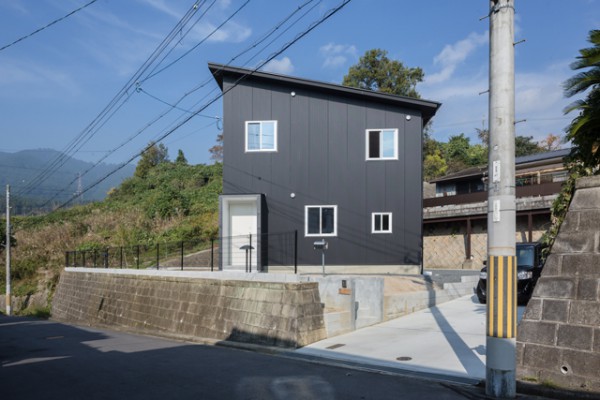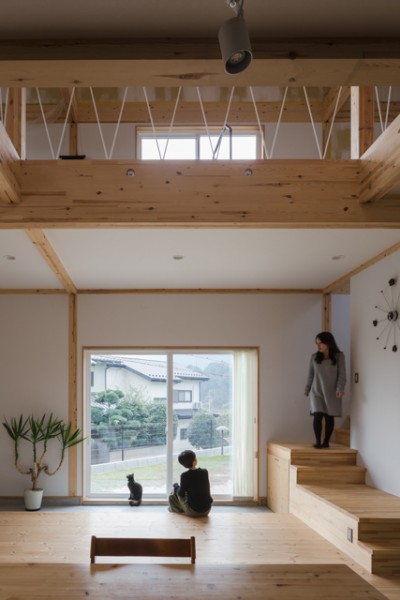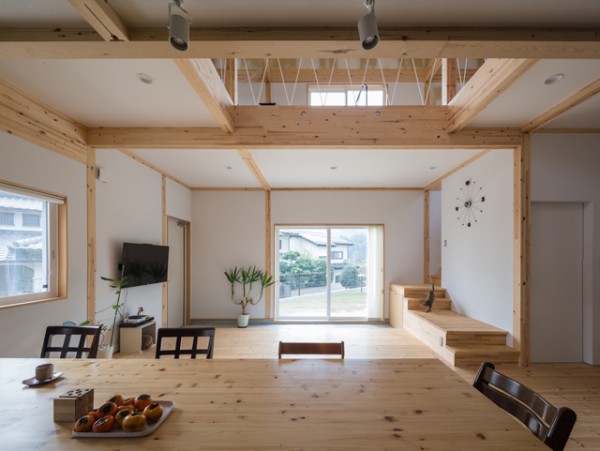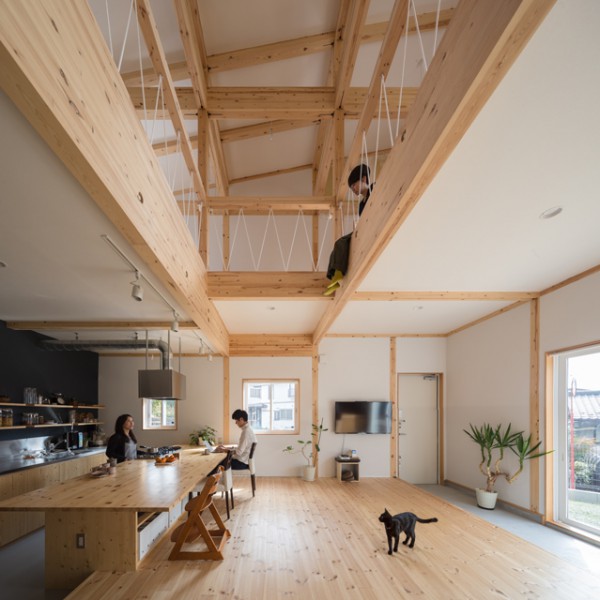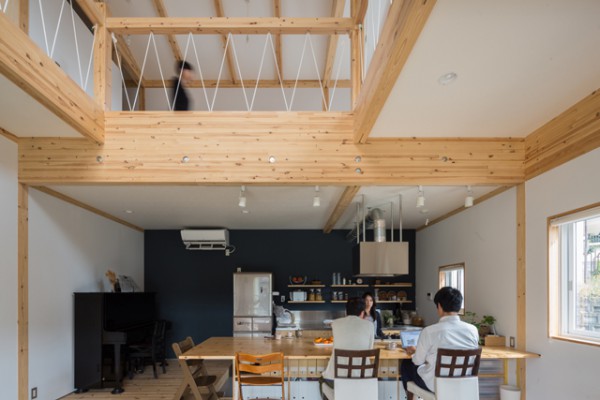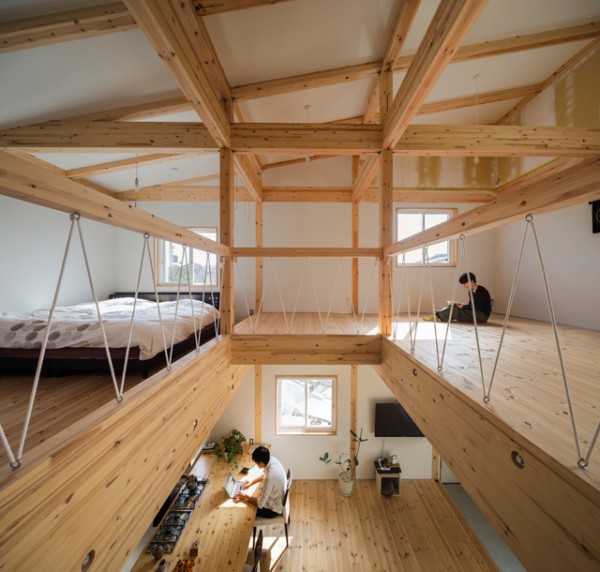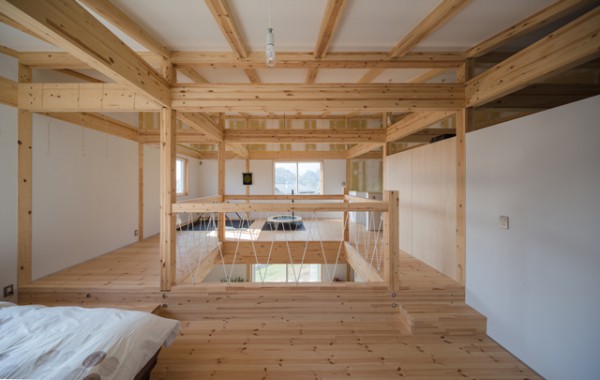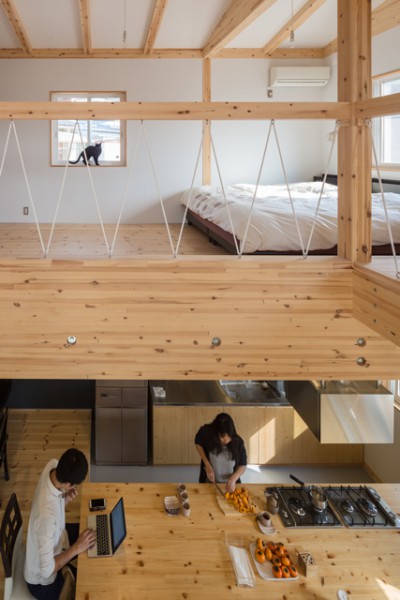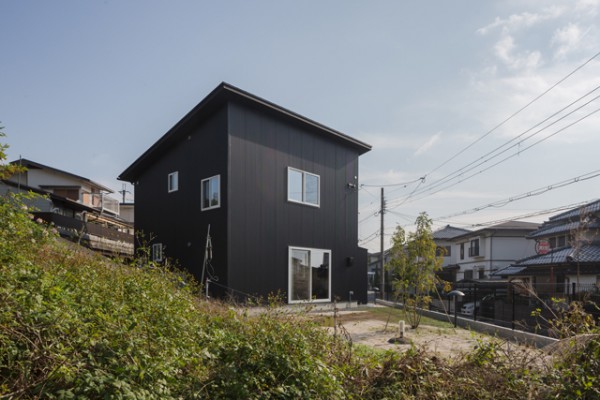主要用途: 住宅
構造設計: エヌ・シー・エヌ
設備設計: 遠藤照明(照明)
施工: 住まい設計工房
所在・会場: 滋賀
敷地面積: 334.39m2
延床面積: 99.29m2
規模: 地上2階
構造: 木造SE構法
設計期間: 2015.7-2016.9
施工期間: 2016.12-2017.6
写真: 新建築社写真部
ウェブサイト: https://www.ncn-se.co.jp/se/
SE構法(木造ラーメンのシステム構法)を開発したエヌ・シー・エヌが2014年に主催したMAKE HOUSE展において、同構法のパーツ化というテーマの元、私たちは「開かれた家」というコンセプトを提案した。部材のパーツ化と、金物のジョイントによる工法の単純化で、構造現しの意匠が容易になり、住み手に建物の構造を理解しやすくし、家をつくるという専門領域を開くことができる。また、シンプルな軸組と工法は将来的な増改築が容易になり、部屋の組み換えや家の境界も自由にでき、多彩な住まい方をもたらす。例えば1階をギャラリーや教室として、街に対して開かれた家をつくることもできる。 この「開かれた家」というコンセプトに共感したクライアントのために、4人家族のための住宅を計画した。敷地は、琵琶湖を望むひな壇状に造成された傾斜地で、定期的に行われる料理教室のための大きめなキッチンと、空気がゆるやかにつながる一体的な空間をのぞまれた。 隣家を避けて眺望が確保できるように、敷地の中で大きく角度を振る配置とした。1階は、アイランドキッチンのカウンターを拡大した大きなダイニングテーブルを中心に、広い土間空間と連続するリビング、水回りが取り巻く、おおらかなワンルームの空間になっている。2階は中央の吹き抜けを介してつながっており、格子状の構造グリッドを用いた段差で、スキップフロアのような構成を持つ。寝室、子供部屋、将来的な余白のスペースを、その段差がゆるやかに仕切り、1階と同様にひとつながりの空間となっている。 柱・梁の基本パーツと、小梁などの追加パーツに分け、基本パーツで骨組をつくり、追加パーツを使って床を取り付けている。MAKE HOUSE展で提案した「開かれた家」のとおり、ライフスタイルの変化に対応するオープンなシステムにすることで、家をつくる行為そのものを開かれたものにしつつ、料理教室を通じ、街に対しても開かれた家になる。 将来的な余白を残した無垢の構造体が、住み手をおおらかに受け止める。
Principle use: HOUSE
Structural design: NCN
Facility design: ENDO-Lighting (Lightings)
Production: Sumaisekkeikobo
Building site: Shiga
Site area: 334.39m2
Total floor area: 99.29m2
Number of stories: 2F
Structure: Wood (SE structure)
Design period: 2015.7-2016.9
Construction period: 2016.12-2017.6
Photo: shinkenchiku-sha
Website:https://www.ncn-se.co.jp/se/
At the MAKE HOUSE exhibition hosted in 2014 by NCN, developers of the SE building method (timber frame structure system building method), we proposed the concept of “Opened House” under the theme of breaking down this building method into its parts.By breaking down components into parts and by simplifying the construction method through metal fixtures, it is easier to reveal the structural design, easier for its users to understand the structure of the building, and it allows us to open up the technical domain of house-building. Additionally, a simple framework and construction method make future extensions and structural alterations easier and allows dwellers to freely rearrange rooms as well as the boundaries of the house, which in turn brings about diverse ways of living. For example, it is possible to build a house opened to the city with the first floor as a gallery and classroom.We planned a house for a family of four for a client who understood our concept of an “Opened House”. The site is on sloping land created in the shape of a tiered gallery that commands a view of Lake Biwa, and deliverables included a large kitchen to regularly carry out cooking classes as well as a unified space to loosely connect the atmosphere.To ensure a view that avoided neighboring houses, we arranged it at an angle within the site. The first floor is a large, one room space with surrounding wet area centered on a large dining table that expands the counter of the island kitchen, as well as a living room connected to the wide pit space. The second floor is connected through the central atrium, and it maintains a skip floor-like layout thanks to its elevated floor which uses a lattice-shaped grid construction. The bedroom, children’s room, and future blank spaces are loosely partitioned by the elevated floor, and it is one connected space just like the first floor. Parts were divided into basic parts, like pillars / beams, used to build the skeleton and additional parts, like smaller beams, used to set the floors. Just like the “Opened House” we proposed at the MAKE HOUSE exhibition, we made the act of building a house itself open and, through cooking classes, made the house open to the city by adopting this open system that adapts itself to changes in lifestyle.Thus the untouched structure is left behind as a future blank space that openly accomodates its occupants.
